Narrow the Conflict
Objective
To advance measures that directly improve Israeli and Palestinian lives and livelihoods, with a focus on sustainable Palestinian economic and civic development.
This section lays out a detailed set of options, which could be pursued in tandem or in sequence.
Narrative
Objective
Address symbolic and narrative aspects of the conflict to acknowledge sacred values, humanity, identity and dignity. Acknowledging symbols and narratives will allow a more inclusive process that mitigates opposition and is designed to generate new buy-in from parties ideologically opposed to a two-state solution.
Since the end of the Cold War, the dominant paradigm in conflict resolution has been a classic, liberal approach, which emphasizes the correlation between advancing human rights, free markets, liberal democracy, international law, and the promotion of global peace. By inextricably tying together the acceptance of liberal norms with peace, well intentioned diplomatic initiatives often inadvertently produce so-called spoilers. Experience has shown that if religious communities are forced to choose between preserving their identities or making sacrifices for an untested peace agreement, identities win out.1 Ofer Zalzberg, “Beyond Liberal Peacemaking,” Review of Middle East Studies, Volume 53, Issue 1, 21 May 2019.https://www.cambridge.org/core/journals/review-of-middle-east-studies/article/beyond-liberal-peacemaking-lessons-from-israelipalestinian-diplomatic-peacemaking/46D41E48C271453E0A4794E00F4AC07F/share/eb90ffb2a74c887e4fd684d6453651758383687f
In the Israeli-Palestinian context, the liberal paradigm has predominated, at least since Oslo. It has been the exclusive model and a central feature of third-party diplomacy, yet it has long alienated a number of influential constituencies and kept them from engaging in the diplomatic process. Many Ultra-Orthodox Jews and religious Zionists, as well as moderate Palestinian “Islamists,” perceived the Oslo process and peacemaking efforts that followed as an attempt to advance international law at the expense of their respective religious laws, the Halacha and the Shariʿa.
From this traditional point of view, liberal peacemaking efforts can be seen as an attempt to override the values and religious laws of local communities with the secular, more universal laws of a purportedly liberal “international community”. Similarly, the goals of liberal peacemaking—e.g. partitioning territory, an “end of conflict” and “end of claims”—appear to close the horizon for fulfilling deep-rooted eschatological beliefs, which in certain readings of Judaism and Islam depend on each party’s ultimate full control of the land. Some religious stakeholders have, therefore, come to view liberal peacemaking efforts as diametrically opposed to the intent and meaning of the prayers they conduct several times a day.
Managing a peace process that successfully navigates across worldviews requires a different approach.
- Peacemaking should shift from aiming to produce a single document constructed from within a particular worldview to producing several documents jointly capable of encompassing multiple frameworks. The negotiation of a rights-based peace treaty as per international law should not be viewed as the exclusive embodiment of peace. Peacemaking should be viewed more expansively, with a rights-based treaty seen as one of several necessary building blocks.
- Peacemakers should engage stakeholders on their own terms, within the stakeholder’s own worldview. Above all, this requires acknowledging the non-negotiable sacred values of each worldview and working to reframe them rather than facilitating crude compromises to negate them.
- Participation of religious and cultural authorities should be integrated from the beginning of the process so that their worldviews are represented and add legitimacy to the process.
- Peacemakers should encourage stakeholders to develop “delicate” political strategies and actions consistent with their worldviews. Peacemaking outside the liberal paradigm should not demand that stakeholders justify their strategies in liberal terms. Peacemakers should allow the parties to express their own disparate justifications for constructive actions.
Recognition of Peoplehood, Dignity, and Attachment to the Land
In terms of process, U.S. negotiators should:
- Acquire literacy of each worldview, particularly its conflict-relevant motivators. They can then share with those able to catalyze the worldview’s evolution (e.g. religious authorities, nationalist poets, etc.) the relevant knowledge about decision making processes so these actors (a) better understand how their worldview prohibitions come into play and, at U.S. request, (b) convey, in private, to mediators whether and how prohibitions and religious scripture could be respected in a manner that permits reaching understandings;
- Probe with the Israeli government, Israeli religious Zionists, Israeli Ultra- Orthodox, PLO and Hamas (through a mediator) for a set of formulas designed at winning maximal acceptance within disparate worldviews;
- Work with religious authorities to reframe prohibitions that inform flashpoints or prevent attempts to find common ground such as the prohibition on foreign sovereignty in the Holy Land. Specifically, the United States can catalyze:2 See more prohibition on foreign sovereignty in the Holy Land https://drive.google.com/file/d/1TyIy7s4fqjGbUa9WWNSByYaygutrfn2R/view?usp=sharing
- Tacit Israeli and Jewish recognition of Palestinian and Muslim attachments to the Holy Land, al-Quds and Haram a-Sharif;3 Holders of pluralist worldviews can extend explicit recognition of tenets of other parties that hold contradictory narratives. Non-pluralists (i.e. monists who believe there is one and only truth) can at most extend tacit recognition, by choosing to behave in a manner which does not preclude adversaries from realizing their narratives, yet avoiding explicitly recognizing it as legitimate.
- Tacit Palestinian recognition of Jewish attachments to the Holy Land, Yerushalayim (Jerusalem) and the Temple Mount; and,
- The U.S. can build upon existing guiding principles as well as concrete examples based on cross-worldview peacebuilding work that has already taken place, notably with conservative, right-leaning Israeli and Palestinian Islamist authorities.4 See annex, “Rewording and Reframing in Conflict Transformation: Guiding Principles and Concrete
Examples from Mediation in the Israeli-Palestinian Context.”
Given the UN’s norm of referring to this territory exclusively as the West Bank or the Occupied Palestinian Territories (OPT), it would be meaningful to have UN bodies and/or other recognized third-parties (i.e. World Bank) acknowledge that the land is known both as the West Bank to many Palestinians and Arabs and as Judea and Samaria to many Jews and Christians. The UN could elaborate that Judea and Samaria is the appellation Jews and many Christians have used to describe this territory since biblical times and that according to the bible several major events have taken place in these areas. Considering recent controversies surrounding UNESCO, it would be particularly powerful if that body, or its representatives, made such an acknowledgement.
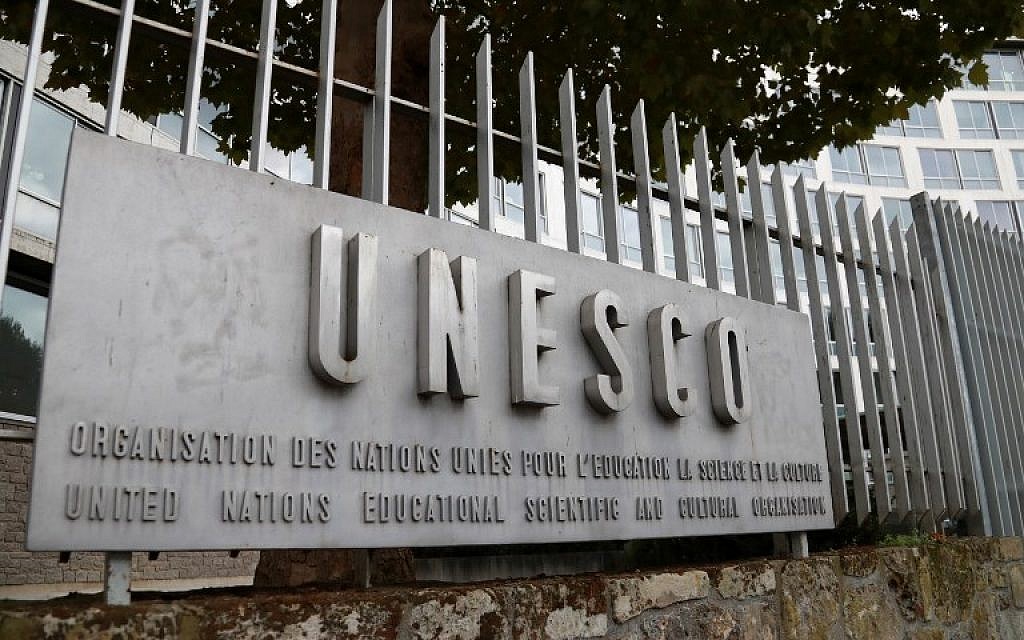
Headquarters of the Educational, Scientific and Cultural Organization (UNESCO) in Paris (Jacques Demarthon/AFP, 2017)
Baptism in the Jordan River
Organize cooperation between the PA, Israel and Jordan to rehabilitate the Jordan River and ensure open access to the baptism site that is both safe and sustainable for years to come.
Intra-Christian Understanding
Promote cooperation between Arab Christian churches (Orthodox, Catholic and other) and U.S. Evangelical churches to create better understanding of the issues driving the Israeli-Palestinian conflict and U.S. policy.
Treatment of Christian institutions and communities in the Palestinian Territories and Israel
Christian pilgrims often learn at Christian hotels, monasteries and communities that Christian life in the Palestinian Territories and Israel involves unnecessary hardship. These concerns should be addressed by both the Palestinian Authority and Israel. In the Palestinian Territories, the PA could consider adopting new laws and regulations to ensure stronger representation of the Christian minority in the government and work with the Church to better identify and achieve economic and social objectives. In Jerusalem, Israel could consider easing tax and temporary residency requirements applied to Christian institutions.
Joint tourism in Jordan/Israel/Palestine
Walking the path of the patriarchs of the Bible is a vision for pilgrims of all three monotheistic faiths and advancement towards peace helps enable this vision become reality for communities of faith. The Abraham Path Iniative was the first attempt to create a trail through the Middle East so that the faithful can follow the steps of those chronicled in the Bible.
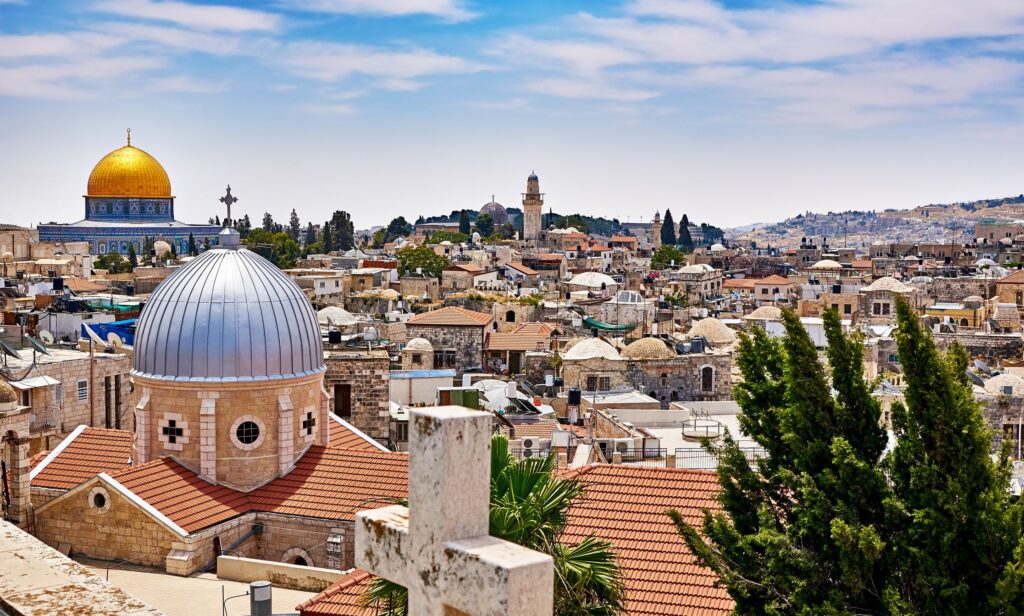
The Holy city of Jerusalem (Kyrylo Glivin/EyeEm/Getty Images, 2019)
There are different ways the United States can encourage the Israeli and Palestinian leadership to provide mutual acknowledgement of Jerusalem’s importance to each society which would have substantial reverberations throughout Israel, the Palestinian Territories and worldwide and dramatically improve the political dynamic in both societies, as well as religious communities in the U.S. surrounding the conflict.
One option is for the U.S. to issue an American statement that is formally and publicly welcomed by both sides possibly along these lines:
“The Jewish and Palestinian peoples are in many ways kindred spirits. Both peoples have coalesced around the national vocation of maintaining the integrity of Jerusalem/Yerushalayim/al-Quds and the sanctity of the Temple Mount. While the three monotheistic faiths-Judaism, Islam and Christianity-differ in significant ways, they share a yearning that the word of God will come from Jerusalem to the entire world and that the city will welcome all those coming near and afar in the quest for the Divine and moral and ethical inspiration.”
The second option is to coordinate two separate declarations by the Israeli and Palestinian leadership to their own people conveying a nuanced, but groundbreaking text possibly along these lines:
Israeli:
“The Palestinian people did not first organize themselves to oppose the creation of the State of Israel. Rather, they began coalescing before Israel’s establishment around the national vocation of maintaining the integrity of Jerusalem, which they call al-Quds, to prevent those who are foreign to the city and the land surrounding it from defiling it. Isaiah (62:6) spoke of placing guardians around Jerusalem. The real question is whether we can protect the city’s integrity together, rather than from each other.”
Palestinian:
“As we read in the Quran and in the New Testament, the Jewish people have been yearning in their prayers for Jerusalem, which they call Yerushalayim, since the Roman era. Jewish tradition ascribes unique rights for Jews to the city, yet describes it predominantly as a City of God, rather than as belonging to any single nation”.
Statements of this sort could lay the groundwork for speaking of al-Quds as the capital of a new state of Palestine and Yerushalayim as the capital of Israel. Most importantly, such sentiments could begin to chip away at the zero-sum dynamics pertaining to negotiations over Jerusalem.
The U.S. approach to incitement, education and creation of a culture of peace must include both Palestinians and Israelis. As proposed in the “Peace to Prosperity” Plan offered by the Trump administration, the U.S. could lead a Joint Commission on Acceptance and Tolerance or a similar committee that would survey incitement on both sides and offer recommendations for change and dialogue.5 For a methodology see the comprehensive 2013 U.S.-funded research, which reviewed incitement on both sides, in Bruce Wexler et al., “Victims of Our Own Narratives? Portrayal of the ‘Other’ in Israeli and Palestinian School Books”, Council of Religious Institutions of the Holy Land, February 4, 2013. Online at http://d7hj1xx5r7f3h.cloudfront.net/Israeli-Palestinian_School_Book_Study_Report-English.pdf.
Regional Track: A “New and Improved” Arab Peace Initiative
The Israel-UAE, Bahrain, Morocco and Sudan agreements, and others that may follow, offer the United States a golden opportunity to encourage Saudi Arabia and more reticent Arab states to translate the Arab Peace Initiative (API) from a vision statement into a blueprint for sustainable peace in which constructive steps by Israel and the Palestinians to build a two state reality aimed at improving lives and narrowing the conflict will be rewarded by increasing levels of normalization with Israel and dedicated financial support to the Palestinians. Enhanced levels of political, economic and security cooperation with Israel should be designed to also benefit Palestinians where practical. The more explicitly Israel moves toward enabling a two-state reality, the more robust the response of the Arab states should be.
Too much U.S. reliance on the API, however, would be a miscalculation. Framing explicitly within the API would actually reduce the Israeli government’s receptivity because the API is anchored in Israeli acceptance of the 1967 lines as a basis for drawing a border. Israel views the API as front-loaded with Israeli concessions, and normalization coming only at the end of the process. Notably, the Israel-UAE, Bahrain, Morocco and Sudan agreements are not dependent on Israeli acceptance of the 1967 lines. Rather, for both policy and political considerations, any Israeli leader would be more likely to embrace an American vision for normalization than the API.
Through a strategy of inclusivity, the U.S. can orchestrate more normalization agreements which would win greater acceptance among Palestinians and therefore would involve less of a political burden on the Arab side. Also, inclusivity has the added benefit of pushing Iran to the sidelines of Palestinian politics, leaving it at most as a sponsor of Palestinian Islamic Jihad.
Material
Objective
The U.S. should simultaneously engage with Israel and the Palestinian Authority to encourage constructive developments on the ground and advance Palestinian state building.
Promote Constructive Developments in Palestinian State Building
An international consensus supports further developing the capabilities of the PASF and upgrading its cooperation with Israeli security institutions. But the U.S. must be cognizant of the competing views surrounding the ultimate objectives of enhancing the Palestinian forces and the required reforms.
The same fault lines and interests which characterize the Israeli-Palestinian conflict, also shape the debate about Palestinian security sector reform. For a majority of Palestinians, security sector reform is needed to achieve a functional security sector designed to protect them against Israeli incursions and provide the basis for statehood and sovereignty. Palestinian civil society leaders view security reforms in the context of promoting democracy and protecting a democratic society. Israel, in turn, views Palestinian security sector reform as a means to enhance its own security and confront the infrastructure of terror, but limited so as not to constitute a danger to Israel.
The United States should take the position that expanded Palestinian security force training and reform initiatives are the logical follow up actions to actualize and lock-in President Abbas’ commitment that a newly created Palestinian state would be “non-militarized.” Thus, enhancing capabilities of Palestinian security forces becomes a benchmark to be satisfied and is consistent with building a two-state reality and the Israeli imperative to minimize its footprint in Palestinian population centers.6 Roland Friedrich Arnold Luethold (Eds.), Entry-Points to Palestinian Security Sector Reform, Geneva Centre for the Democratic Control of Armed Forces (DCAF), 2007, https://www.dcaf.ch/sites/default/files/publications/documents/Entry-Points%28EN%29.pdf;Roland Friedrich, Arnold Luethold and Firas Milhem (Eds.), The security sector legislation of the Palestinian National Authority, Geneva Centre for the Democratic Control of Armed Forces (DCAF), 2008, https://www.dcaf.ch/sites/default/files/publications/documents/final_EN.pdf; andNeri Zilber and Ghaith al-Omari, State with No Army, Army with No State – Evolution of the Palestinian Authority Security Forces, 1994–2018, Washington Institute for Near East Policy, Policy Focus 154, March 2018, https://www.washingtoninstitute.org/uploads/Documents/pubs/PolicyFocus154-ZilberOmari.pdf.
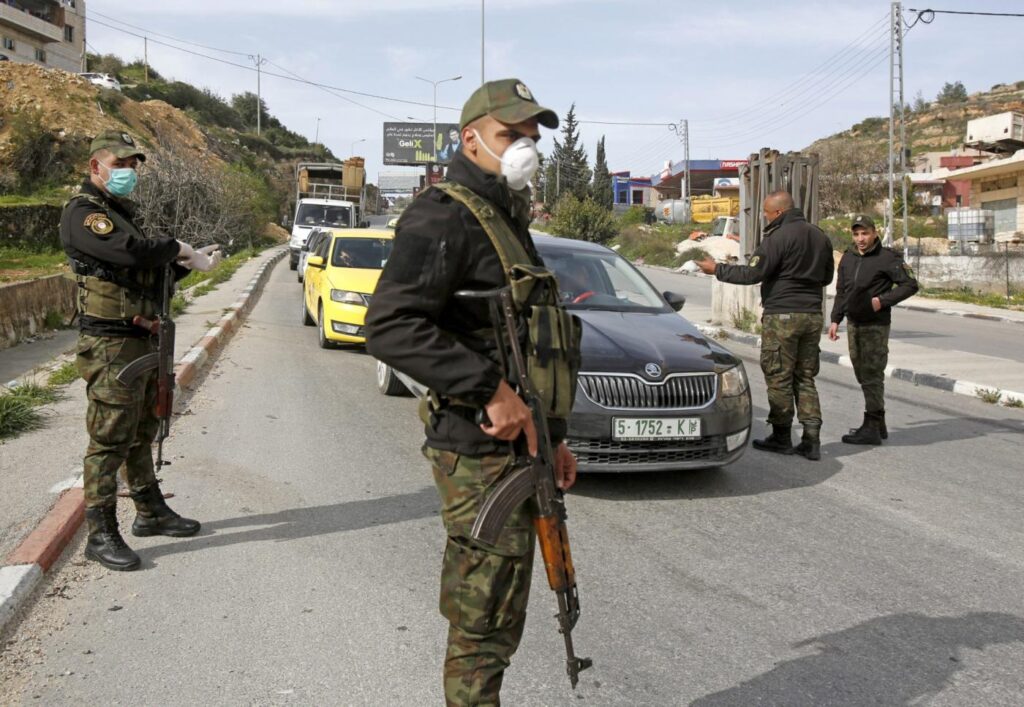
Palestinian security forces man a Bethlehem checkpoint, when the city fell under lockdown due to coronavirus (AFP/2020)
The Israeli Government can permit the operation of an exclusively bureaucratic Palestinian institution extending a wide array of municipal services to Palestinians in East Jerusalem, for example taking on some of the long-closed Orient House’s former functions. This would require the institution’s commitment to refrain from using its capacities to support diplomatic campaigns, legal challenges or popular protests against Israel. Jordan’s Waqf could initially provide a diplomatic umbrella for such an institution, making it less controversial for Israelis.7 Reversing Israel’s Deepening Annexation of East Occupied Jerusalem, Crisis Group Report No 202, June 12, 2019, https://www.crisisgroup.org/middle-east-north-africa/eastern-mediterranean/israelpalestine/202-reversing-israels-deepening-annexation-occupied-east-jerusalem
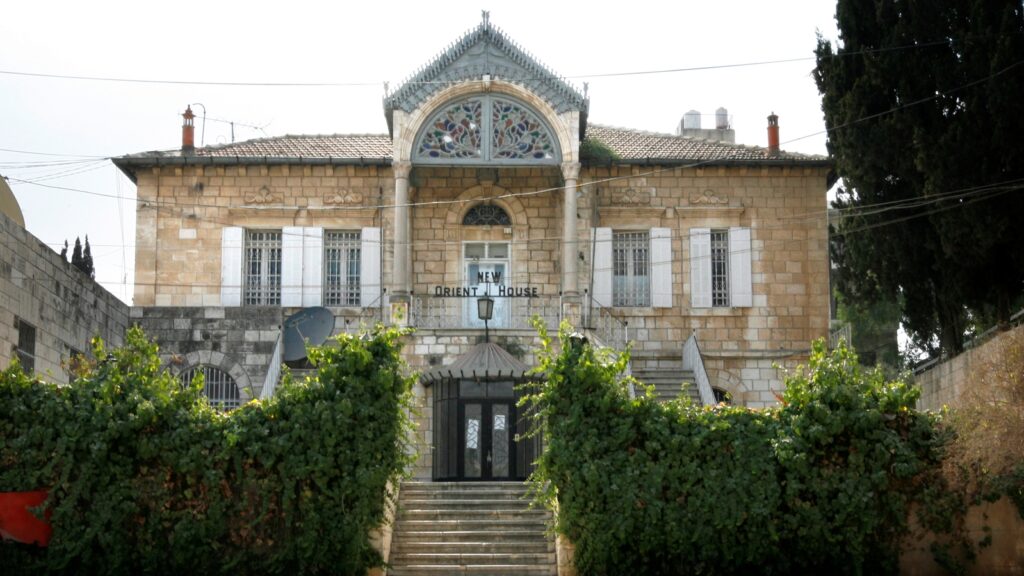
The Orient House in Jerusalem (Nati Shohat/Flash90)
The Palestinian autonomous zones are too small for the population and cannot accommodate current growth rates. Areas A and B in the West Bank—where most Palestinians live—have not expanded since the 1990s, despite tremendous population growth. As a result, Palestinians have built roughly 20,000 housing units that spill over the boundaries of the autonomous zones.8 See map below Since they were built without permission from Israeli military authorities, the construction is largely unregulated and exists under threat of IDF demolition. Multiple, non-partisan studies by former Israeli security officials, including the Institute for National Security Studies (INSS) and Commanders for Israel’s Security (CIS), propose that Israel transfer small batches of West Bank territory to the Palestinian Authority to enable natural growth in a regulated and economically viable way. Such a transfer could include roughly 3.8% of the West Bank and Gaza. Priority should be given to land that is adjacent to Palestinian populated or cultivated areas. With so much pent up demand, the resulting construction boom would lift the overall Palestinian economy.
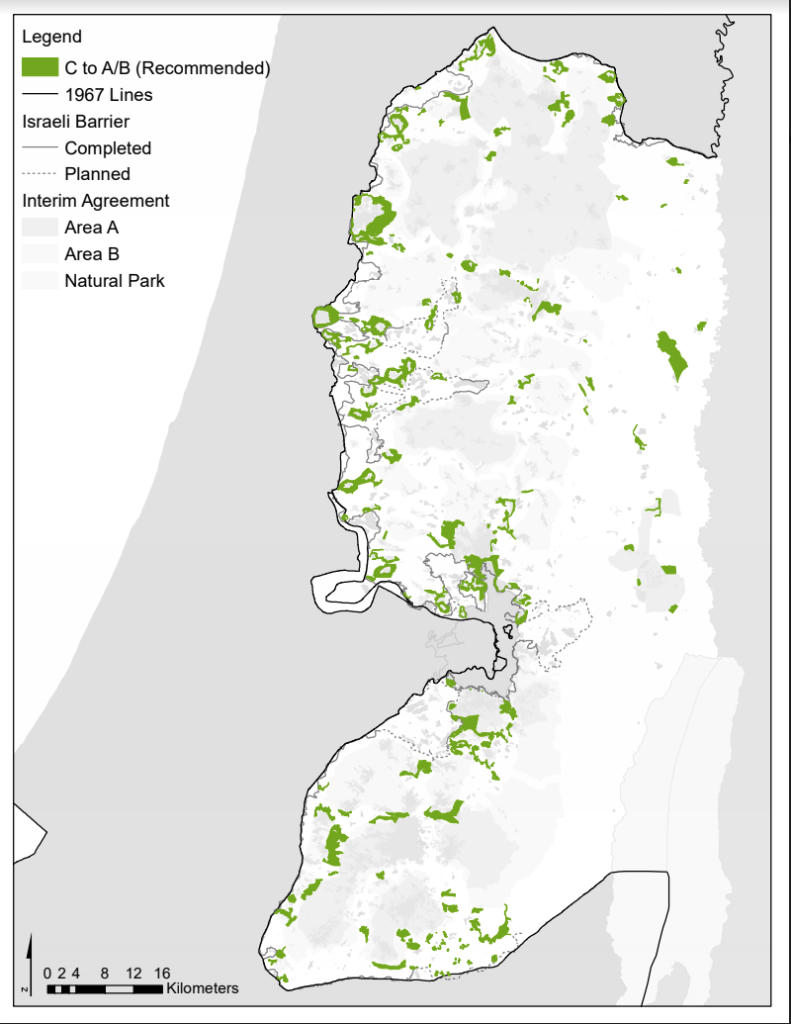
Map showing possible 3.8% land transfer from Area C to Areas A/B
Palestinians in the West Bank and Gaza must now use three different currencies- Jordanian Dinar (JD), U.S. Dollars (USD) and Israeli Shekels (NIS). The three currencies are utilized in various transactions; land sales are in JD, apartments and car sales are in USD and daily purchases such as gasoline and groceries are in NIS. Use of three currencies is highly inefficient and causes significant problems for local banks attempting to balance currencies and is detrimental to economic growth. Palestinian banks often find themselves at the mercy of the Israeli Central Bank and other central banks to buy billions of shekels, dinars and dollars. Thus, Palestinian banks often hold large currency reserves which is highly inefficient and limits their ability to contribute to economic development.
Likewise, the Palestinian Monetary Authority has no ability to print money or act as a central bank which is required to develop a currency and control fiscal policy. Without such capabilities, Palestinians lack the financial tools to manage their own financial system and develop a sense of sovereignty. Thus, it is essential that Palestinians have the opportunity to establish credit worthy financial institutions capable of engaging in international market transactions with appropriate governance and a central banking authority.9 https://themedialine.org/by-region/the-west-bank-is-drowning-in-shekels/
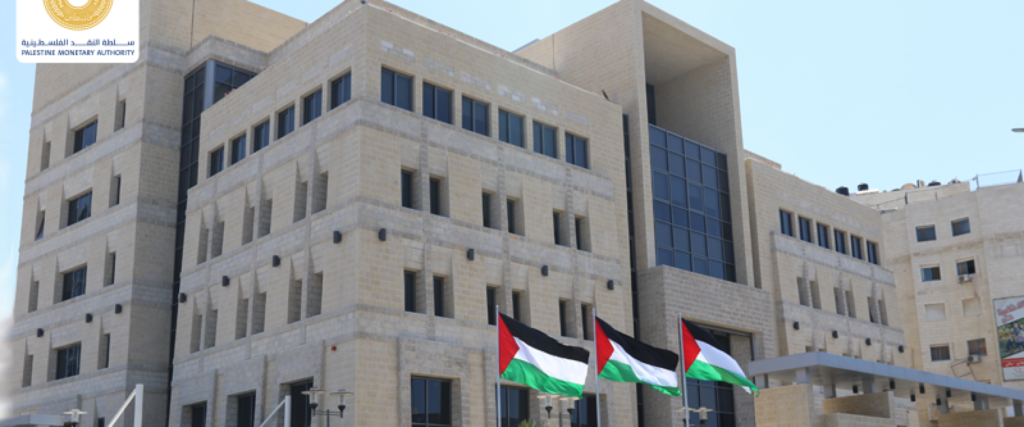
The Palestinian Monetary Authority (PMA) headquarters in Ramallah (pma.ps)
With the climate crisis, the need for water and energy security has never been greater. Over the past 20 years advancements in water technologies, including Israel’s adoption of conservation strategies and its huge investments in desalination, present the opportunity for Palestinians to gain greater access without reducing water availability on the Israeli side. The utilization of treated wastewater for agriculture and the development of membrane desalination technology means that water is under less constraint as a resource.
Compared to the other final status issues of Jerusalem, refugees, borders/settlements and security, water is today the least controversial and most solvable of final status issues, yet progress has remained elusive. Moving quickly to resolve water issues offers a potential early diplomatic victory for all sides as it would substantially improve living conditions for Palestinians while maintaining water security for Israelis.
By adding solar energy into the mix, where Jordan has a comparative advantage due to its vast desert areas, a win-win-win regional water and energy security strategy can be pursued. The three-way agreement would have Jordan sell solar energy to Israelis and Palestinians and Israeli and Palestinian desalinated water from the Mediterranean would be sold back to Jordan thereby delivering regional natural resource, economic and geo-political cooperation.
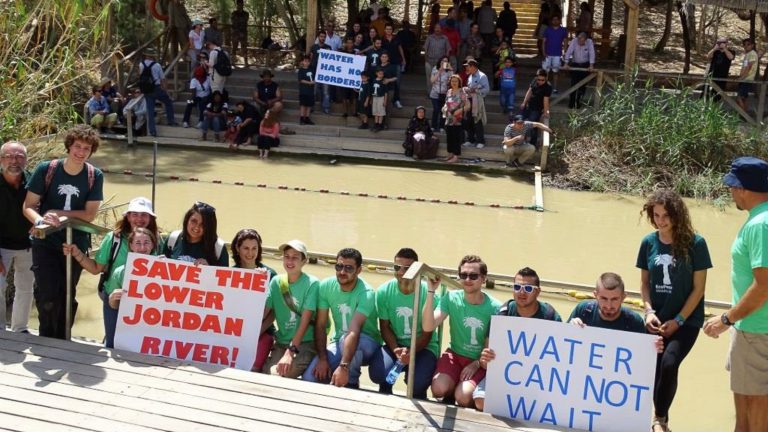
EcoPeace’s Youth Water Trustee program, which brings together young people from across borders in the Jordan Valley, campaign for river rehabilitation.